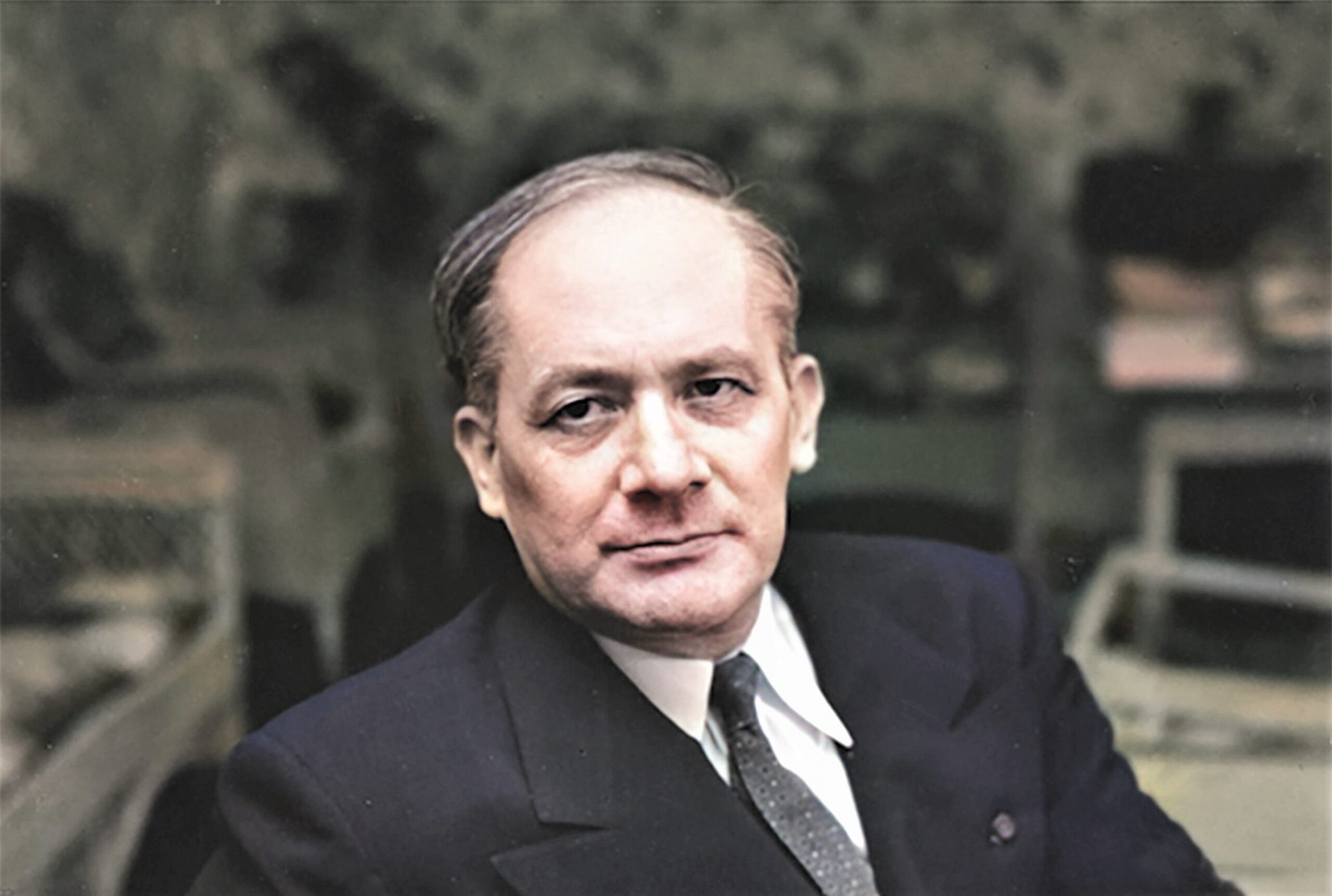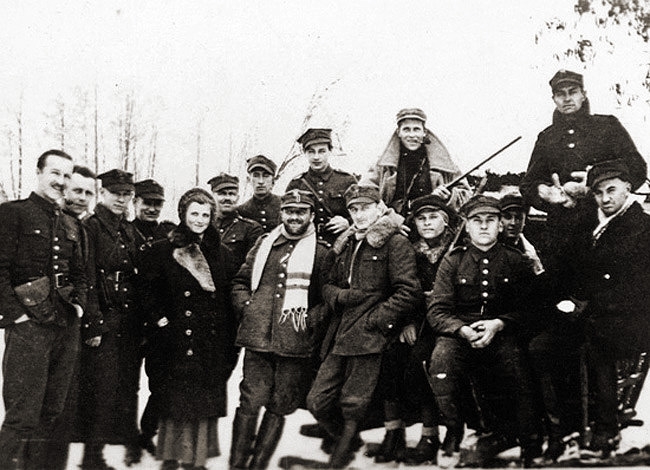In 1945, when the search for and exhumation of the bodies of the victims of German terror was just beginning in occupied Poland, a 22-year-old Polish poet, future winner of the Nobel Prize for Literature, wrote her first poem with the telling title: ‘I am Looking for a Word’.
by Tomasz Ceran
‘I want this one, just a word/to be impregnated with blood,/which like the walls of a dungeon/contains within every common grave./Which describes precisely and clearly/who they were – what happened/Because what I hear,/what is written,/is not enough,/it is never enough,’ she wrote. The young Wisława Szymborska did not find such a word. However, already during the war there was a person who, not in the language of poetry but of international law, wanted to give a name to what happened in German-occupied Poland and all of Europe. That person was a Polish lawyer of Jewish origin, Rafał (Raphael) Lemkin.
Before the war, he had obtained a doctorate in law from the John Casimir University in Lwów, and soon moved to Warsaw, where he pursued a professional and academic career. Already during his studies, reflecting on the mass extermination of Armenians by the Turks during the First World War, and the trial that was brought in 1921 against the Armenian revolutionary Soghomon Tehlirian, the assassin of the Turkish interior minister responsible for the massacre of Armenians, Lemkin wondered why the perpetrator was brought to justice for a single murder, while this was not the case in the exterminated of a nation. As early as 1933, at an academic conference in Madrid, the Polish jurist postulated the introduction of two new categories of international crimes: those of barbarism and those of vandalism. Lemkin defined the former as acts against human life undertaken with the intention of destroying a particular racial, religious or social group, and the latter as acts against the cultural heritage of a national group.

Meanwhile, on 22 August 1939, Adolf Hitler, in an order to the Wehrmacht, called for men, women and children of Polish origin and language to be sent to their deaths without mercy or compassion. At the end of the speech, he asked the pertinent question: ‘After all, who still speaks of the Armenian extermination today?’.
Lemkin did indeed speak about it and remember it. After many adventures, he managed to escape from occupied Poland – via Lithuania, Latvia, Sweden, the Soviet Union, and Japan to Canada, and finally the United States. There, he began work on analysing what was happening in German-occupied Europe. In order to understand the aims of the German occupation policy, Lemkin began to collect and analyse legislation passed in the various occupied countries. The result of this work was a book published in 1944, entitled Axis Rule in Occupied Europe: Laws of Occupation, Analysis of Government, Proposals for Redress (Foundations of the Laws of War). It was on its pages that he used the term ‘genocide’ for the very first time.
Analysing the far-reaching goals of the German occupation, the Polish jurist concluded that ‘New conceptions require new terms. By “genocide” we mean the destruction of a nation or of an ethnic group. This new word, coined by the author to denote an old practice in its modern development, has its origins in the ancient Greek word genos (race, tribe) and the Latin cide (killing).’ According to Lemkin, genocide is not an individual act, but a coordinated plan involving various activities. The jurist distinguished eight genocidal techniques: cultural, social, political, economic, biological, physical, religious, and moral genocide. Their application is aimed at disintegrating political, social and cultural institutions, destroying language and national feelings, religion, the economic basis of a group’s existence, and its personal security, health and identity.

Genocide, according to Lemkin, was a new occupation technique of Nazi Germany, whose aim during the Second War was not the mere occupation of territory, but the extermination of a national group either in part or in its entirety. The overall change in population structure meant an increase in the German population (positive action) and the extermination of a large part of the non-German population (negative action). According to the jurist, genocide comprises two stages: the destruction of the national patterns of life of the attacked group, and their replacement by those of the aggressor. In Lemkin’s theory genocide is not limited to the mass killing of members of a group irrespectively of its scale and degree of cruelty, but is a much broader phenomenon. On the other hand, it is difficult to imagine a theory of genocide without the component of physical genocide – the mass killing of group members because of their membership in it. A reflection on the nature of the German occupation of Poland played a major role in the birth of this concept. The old notions of both ‘denationalisation’ and ‘Germanisation’ appeared inadequate to Lemkin given the reality he observed and analysed. He argued that ‘if one uses the term “Germanisation” of the Poles, for example, in this connotation, it means that the Poles, as human beings, are preserved and that only the national pattern of the Germans is imposed upon them. Such a term is much too restricted to apply to a process in which the population is attacked, in a physical sense, removed, and supplanted by the population of the oppressor nation.’
During the war, Lemkin worked on the concept of genocide understood not yet as an element of a legal definition, but as a description of the historical phenomenon characterising the German occupation of Europe, with particular reference to the situation in occupied Poland. Distinguishing eight genocidal techniques and citing examples of their application in Axis Rule in Occupied Europe: Laws of Occupation, Analysis of Government, Proposals for Redress (Foundations of the Laws of War), he wrote each time about the situation on Polish soil. For him, it was the territory of Poland that was the primary site of the application (practice) of genocidal techniques.
Lemkin attached great importance to cultural genocide. He argued that ‘when a nation is exterminated, something more than the cargo of a ship is lost – a part of humanity with a spiritual heritage in which the whole world participates disappears’. The cultural and biological losses are irreparable; the only thing the aggressor state can do is to pay for war reparations. This was clear to him already in 1944.

After the war, Lemkin sought to make the genocide he described a legal category. He sent his book to well-known lawyers. The American prosecutor Robert H. Jackson described the Nuremberg trial as the ‘greatest historical seminar in history’. During the Nuremberg Trials, the term genocide was not used in the verdict, but the indictment stated unequivocally that the defendants had practised deliberate systemic genocide in an effort to exterminate certain races or social groups, especially Jews, Poles and the Roma. Seven similar, albeit smaller, ‘historical seminars’ were held in post-war Poland.
Between 1946 and 1948, seven trials were held in Poland before the Supreme National Tribunal (Polish acronym: NTN). During the ‘Polish Nuremberg’, the intention was to try key German criminals and serve them justice that would not turn into national reprisal. Three trials were held in Krakow (Amon Göth, 40 Auschwitz staff members, Joseph Büler), two in Warsaw (of the Government of the General Government and Rudolf Höss), and one each in Poznań (Artur Greiser) and Gdańsk (Albert Forster). Despite the fact they took place at a time when hatred towards Germans in Polish society was reaching its peak after six years of occupation, and the communist system was being installed in post-war Poland, the trials before the NTN upheld the highest standards of fair trial. Forty-nine people were indicted and 31 sentenced to death, of whom two were commuted by pardon to life imprisonment (29 death sentences were carried out), 13 sentences of more than ten years in prison were delivered, and one person from the Auschwitz staff, physician Dr Hans Münch, was acquitted.
Six out of seven NTN sentences used the term genocide (a total of 24 times). The judges and prosecutors of the NTN were familiar with Lemkin’s 1944 concept of genocide (Lemkin had already sent a copy of his book to the library of the Jagiellonian University in Krakow in 1945) and considered it the most adequate for the historical description of the reality of the German occupation of Poland. Accused in the trials were not only specific perpetrators, but the entire German occupation policy system. Before the trials, the German occupation of Polish territory was presented as a prepared and consistently implemented plan for the extermination of the Polish nation.

The use of the term genocide in the NTN sentences enabled the judges to morally condemn the crime, and include feelings of contempt, astonishment and horror at the extent of the crime committed. In all NTN judgments, the term ‘genocide’ was used as a historical term, not a legal one. At the same time, the Polish judges could already clearly see the need and necessity to introduce the new crime into international law. This was necessary so that the situation after the First World War, and the failure to punish the perpetrators, would not be repeated. The principle of international impunity was to be replaced by one of international justice. Without the definition of new types of crimes, this was impossible. The imagination of the perpetrators proved to be much greater than that of the world’s legislators.
Lemkin’s efforts culminated in the adoption of the Convention on the Prevention and Punishment of the Crime of Genocide by the UN General Assembly on 9 December 1948. Article I of the above Convention states that: ‘The Contracting Parties confirm that genocide, whether committed in time of peace or in time of war, is a crime under international law which they undertake to prevent and to punish.’ Article II reads: ‘In the present Convention, genocide means any of the following acts committed with intent to destroy, in whole or in part, a national, ethnical, racial or religious group, as such:
(a) Killing members of the group;
(b) Causing serious bodily or mental harm to members of the group;
(c) Deliberately inflicting on the group conditions of life calculated to bring about its physical destruction in whole or in part;
(d) Imposing measures intended to prevent births within the group;
(e) Forcibly transferring children of the group to another group.’

Despite the lack of mention of political groups (Soviet objection) and the cultural genocide that Lemkin cared deeply about (objection of the Western states), this was a milestone in international law. The Polish jurist is seen as the ‘father’ of this document, and it is referred to as the ‘Lemkin Convention’. Lemkin saw it as a starting point – part of a broad prevention plan. He was convinced that it was only from the combination of punishment and prevention that something positive could emerge. Today, the Polish jurist is also recognised as one of the intellectual fathers of a separate academic discipline – genocide studies.
The emergence of genocide as a historical and legal term was closely linked to the analysis of the German occupation of Polish territory. Lemkin’s concept of genocide as a process consisting of eight genocidal techniques makes it possible to comprehensively name and describe the German occupation of Poland.
Author: Tomasz Ceran (PhD, employee of the History Research Office of Institute of National Remembrance)
Translation: Mikołaj Sekrecki





